Things to do in Kyoto
Kyoto is Japan's premier destination for historical sightseeing, so tourists keen to sniff out traditional Japanese culture will love the city. The attractions are numerous but they are also spread out all over the place and sometimes take some finding. However, there's real joy in stumbling upon unexpected treasures in the charming backstreets, and the best way to experience this city is to get lost in it.
Kyoto is full of temples, shrines and gardens, and there is lots to see and do. Sightseeing highlights include the Geisha neighbourhood of Gion, the stunning Kiyomizu-dera water temple, the Fushimi Inari Shrine, the Kyoto Imperial Palace, and the temple of Sanjusangen-do. There are also a number of worthwhile attractions just outside of the city, including the Golden Pavilion and its beautiful gardens.
The easiest way to access Kyoto's tourist attractions (which are not located near subway stations) is by bus. The city is served by multiple bus companies with direct lines from Kyoto Station and several points in the city centre. An English map of the Kyoto City bus network is available from tourist offices, and signs are in English as well as Japanese. Fares are paid on leaving the bus. The only drawback to the buses is that traffic density makes them slow and they can become very crowded.
For getting around the city centre the subway is recommended. Two subway lines cross the city, from north to south and east to west. Kyoto also has a high concentration of taxis, particularly in the city centre.
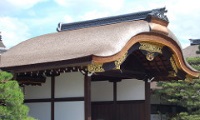
Kyoto Imperial Palace
Japan's imperial family lived in the Kyoto palace from 1331 until 1868 and. today. visitors can view the palace's furnishings and delicate decorations. Once only accessible via a g…
Kyoto Imperial Palace
Japan's imperial family lived in the Kyoto palace from 1331 until 1868 and. today. visitors can view the palace's furnishings and delicate decorations. Once only accessible via a guided tour that required advance booking, the palace grounds can now be entered and viewed at the visitor's leisure without any prior arrangements. English guided tours are possible, and those interested should book a space in advance in order to avoid disappointment by calling at the Imperial Household Agency office.
Visitors should note that even on the official tours it is impossible to enter any of the palace buildings, although visitors should be shown a video and photos showcasing the interiors. There are lockers at the site to store anything visitors don't want to carry while walking around the complex.
Website www.kunaicho.go.jp/eindex.html
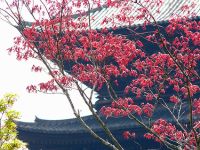
To-ji
To-ji is a Buddhist temple founded in 794 as guardian of the then young capital city. A five-storey pagoda rebuilt in the mid-17th century, a treasure trove of statues, calligraphy…
To-ji
To-ji is a Buddhist temple founded in 794 as guardian of the then young capital city. A five-storey pagoda rebuilt in the mid-17th century, a treasure trove of statues, calligraphy, and paintings has been collected at the temple. The statues include a six-metre-tall Senju Kannon (thousand-armed Buddhist Goddess of Mercy) carved in 877.
The gardens at the temple are lovely and the temple is an active place of worship holding many ceremonies and religious services, giving the place a serene and authentic atmosphere. While there are many temples in the area, To-ji stands out because of its historic pagoda and awesome collection.
Website www.toji.or.jp
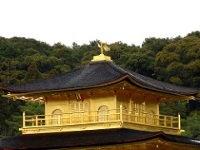
Golden Pavilion (Kinkakuji)
The Golden Pavilion (Kinkakuji) is one of Kyoto's most popular attractions and is located to the north of the city. Surrounded by beautiful gardens, this three-storey pavilion is c
Golden Pavilion (Kinkakuji)
The Golden Pavilion (Kinkakuji) is one of Kyoto's most popular attractions and is located to the north of the city. Surrounded by beautiful gardens, this three-storey pavilion is covered in gold leaf that makes it glitter alongside the waters of a calm pond.
Kinkakuji was built in 1397 as a retirement home for Shogun Ashikaga Yoshimitsu, who lived there in luxury until he died in 1408, after which the building was converted into a Zen temple. In 1950, a monk burnt the pavilion down and it was not rebuilt until 1955.
Today it is covered in gold leaf five times thicker than the original coating and presents an awesome sight. A short walk from the pavilion is Ryoanji, Japan's most famous Zen rock garden, laid out in the 15th century.
Website www.shokoku-ji.jp/en/kinkakuji/
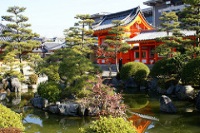
Sanjusangen-do
Once part of a large Buddhist temple complex known as the Lotus King Temple, the temple of Rengeoin is better known by its popular name of Sanjusangen-do. Inside the longest wooden…
Sanjusangen-do
Once part of a large Buddhist temple complex known as the Lotus King Temple, the temple of Rengeoin is better known by its popular name of Sanjusangen-do. Inside the longest wooden building in Japan stands row upon row of life-sized statues of Kannon, the goddess of mercy. They're carved from Japanese cypress and covered in gold leaf, dating back to the 12th and 13th centuries.
There are 1,000 statues and each is unique, bearing a religious symbol or gesture. They surround the large, central figure of a seated Kannon, carved in 1254 in the Kamakura Period. All the golden statues create a hypnotic yellow haze, giving credence to the local myth that if visitors stare at them for long enough one of the statues will assume the form of a loved one.
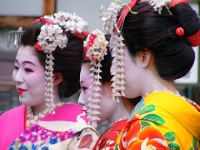
Gion
Most visitors to Japan are fascinated with traditional geisha: white-faced kimono-clad women specially trained to entertain and spoil men in a soothing setting. Kyoto boasts one of…
Gion
Most visitors to Japan are fascinated with traditional geisha: white-faced kimono-clad women specially trained to entertain and spoil men in a soothing setting. Kyoto boasts one of the most famous geisha districts in the country, a neighbourhood of plain wooden buildings to the east of the Kamo River known as Gion.
There were once thousands of geisha and maiko (apprentice geisha) performing their genteel tasks in this area. Today, the number has dwindled to a few hundred, but visitors who stroll Hanamikoji Street at sunset, past teahouses and restaurants, will probably catch a glimpse of one or two en route to the geisha houses in their wooden shoes and full traditional finery.
Website www.insidekyoto.com/gion
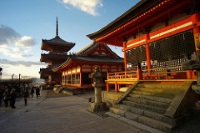
Kiyomizu-dera
Meaning 'pure water', Kiyomizu-dera is one of Japan's most celebrated temples. Founded in 780, it is associated with Nara Buddhism, the oldest sect in Japan. The temple is a UNESCO…
Kiyomizu-dera
Meaning 'pure water', Kiyomizu-dera is one of Japan's most celebrated temples. Founded in 780, it is associated with Nara Buddhism, the oldest sect in Japan. The temple is a UNESCO World Heritage Site and one of its main features for tourists are the lovely views from the terrace of the wooded hills of eastern Kyoto.
Below the terrace is the spring from which the temple got its name; visitors can sample the water said to have healing powers. Nearby is an interesting three-storey pagoda, and the Otowa Waterfall. Behind the temple is the Shinto Jishu Shrine, dedicated to the god of love. There is lots to see and do in the temple complex, which tends to be bustling with visitors and worshippers, and provides a fascinating cultural and historical experience for foreigners.
Website www.kiyomizudera.or.jp/lang/01.html
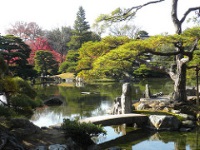
Katsura Imperial Villa
Built in 1645 by Prince Toshihito and considered to be the finest example of pure Japanese architecture and garden design, Katsura Rikyu is beautiful in its simplicity. The buildin…
Katsura Imperial Villa
Built in 1645 by Prince Toshihito and considered to be the finest example of pure Japanese architecture and garden design, Katsura Rikyu is beautiful in its simplicity. The buildings are constructed of entirely natural materials and consist of a moon-viewing pavilion, an imperial hall and a teahouse, as well as the wooden villa itself. The garden is designed for leisurely strolls with surprises around each corner, from stone bridges and lanterns to ponds and manicured trees. The grounds are particularly beautiful in the autumn, when the rich colours of the trees make for even better photos than usual. It's interesting to see how the imperial families lived and the Katsura Imperial Villa is one of the most popular attractions in Kyoto.
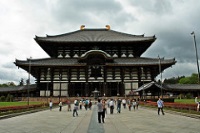
Nara
Originally called Heijo, Nara became the first permanent capital of the country in 710. Although its capital status only lasted for 74 years, they were years that entrenched and en…
Nara
Originally called Heijo, Nara became the first permanent capital of the country in 710. Although its capital status only lasted for 74 years, they were years that entrenched and enshrined Japan's arts, crafts and literature. It flourished as a political and cultural centre and was blessed with numerous temples, pagodas and palaces. Most of Nara's historic treasures are conveniently contained in a vast park, making sightseeing easy and pleasurable. Highlights are Todaiji, the huge temple containing Japan's largest Buddha statue, and Horyuji, the temple containing the world's oldest wooden structures. A good way to explore the city is on a historic walking tour and visitors should ensure that they take a stroll around the old Naramachi merchant district.
Website www.city.nara.lg.jp
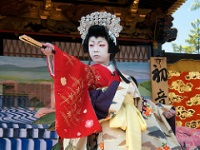
Minamiza Kabuki Theatre
Kabuki is a traditional Japanese dance-drama known for its stylised performance and the elaborate make-up worn by some performers. It enjoyed a golden age in the late 17th and earl…
Minamiza Kabuki Theatre
Kabuki is a traditional Japanese dance-drama known for its stylised performance and the elaborate make-up worn by some performers. It enjoyed a golden age in the late 17th and early 18th centuries, and today is the most popular style of traditional Japanese drama.
While there are many wonderful places in Japan to view kabuki theatre, the Kyoto Minamiza Theatre is one of the principal venues for such performances and a major hub for the art form. The building itself is an architectural wonder, built in a traditional style in 1929, on the edge of the Geisha district of Gion.
Website www.kabuki-bito.jp/eng/top.html



